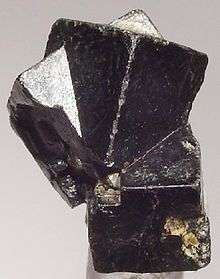Thorianite
Thorianite is a rare thorium oxide mineral, ThO2.[4] It was originally described by Ananda Coomaraswamy in 1904 as uraninite,[5] but recognized as a new species by Wyndham R. Dunstan.[6] It was so named on account of its high percentage of thorium; it also contains the oxides of uranium, lanthanum, cerium, praseodymium and neodymium. Helium is present, and the mineral is slightly less radioactive than pitchblende, but is harder to shield due to its high energy gamma rays. It is common in the alluvial gem-gravels of Sri Lanka, where it occurs mostly as water worn, small, heavy, black, cubic crystals. The largest crystals are usually near 1.5 cm. Larger crystals, up to 6 cm (2.4 in), have been reported from Madagascar.
| Thorianite | |
|---|---|
 Group of interpenetrating twinned thorianite crystals from Ambatofotsy, Madagascar (size: 1.6 x 1.4 x 1.3 cm) | |
| General | |
| Category | Oxide mineral |
| Formula (repeating unit) | Thorium oxide, ThO2 |
| Strunz classification | 4.DL.05 |
| Crystal system | Isometric |
| Crystal class | Hexoctahedral (m3m) H-M symbol: (4/m 3 2/m) |
| Space group | Fm3m |
| Unit cell | a = 5.595 Å; Z = 4 |
| Identification | |
| Color | Dark gray, brown-black |
| Crystal habit | Cubic crystals, usually rounded to some degree in detrital deposits |
| Twinning | Penetration twins on {111} common |
| Cleavage | Poor/Indistinct |
| Fracture | Irregular to uneven, sub-conchoidal |
| Mohs scale hardness | 6.5 – 7 |
| Luster | Resinous, sub-metallic |
| Streak | Grey, grey green to black |
| Diaphaneity | Opaque, translucent on thin edges |
| Specific gravity | 9.7 |
| Optical properties | Isotropic |
| Refractive index | n = 2.20 – 2.35 |
| Other characteristics | |
| References | [1][2][3] |
Chemistry
Based on color, specific gravity and composition three types of thorianite are distinguished:[7]
- α-thorianite
- β-thorianite
- γ-thorianite
Thorianite and uraninite form a complete solid solution series in synthetic and natural material.[8] The division between the two species is at Th:U = 1:1 with U possibly making up to 46.50% and Th ranging up to 87.9%.[9] Rare earths, chiefly Ce, substitute for Th in amounts up to 8% by weight.[8][10] Ce is probably present as Ce4+. Complete series is known in synthetic material between CeO2 - PrO2 - ThO2 - UO2. Small amounts of Fe3+ and Zr also may be isomorphous with Th. Pb present is probably radiogenic.
Varieties
Occurrence
Usually found in alluvial deposits, beach sands heavy mineral placers and pegmatites.
- Sri Lanka – In stream gravels, Galle district, Southern Province; Balangoda district; near Kodrugala, Sabaragamuwa Province; and from a pegmatite in Bambarabotuwa area.
- India – Reported from beach sands of Travancore (Kerala).[15]
- Madagascar – Found in alluvial deposits of Betroka and Andolobe.[16] Also as very large crystals from Tôlanaro (Fort Dauphin); at Andranondambo and other localities.
- Russia – In black sands of a gold placer on Boshogoch River, Transbaikalia, Siberia; in the Kovdor Massif by Kovdor, Kola Peninsula; in the Yenisei Range, Siberia.
- United States – reported from Easton, Pennsylvania; black sands in Missouri River, near Helena, Montana; Scott River, Siskiyou County, California;[17] black sands in Nixon Fork and Wiseman districts, Alaska.[18][19]
- Canada – Reported with uraninite in a pegmatite on Charlebois Lake, east of Lake Athabasca;[20] Uranon variety reported from pegmatite and metesomatized zones in crystalline limestones from many locations in Quebec and Ontario.[21]
- South Africa – Occurs with baddeleyite as an accessory in carbonatite at Phalaborwa, Eastern Transvaal.[22]
- Democratic Republic of Congo - Kasaï region[23]
See also
- Uraninite
- Thorite
- Classification of minerals
- List of minerals
References
- Handbook of Mineralogy
- Mindat.org
- Webmineral data
- Frondel, C. (1958). Systematic Mineralogy of Uranium and Thorium. United States Government Printing Office.
- Coomaraswamy, A.K. (1904). "Uraninite". Spolia Zeylanica. Pt. 6 (2): 57.
- Dunstan, Wyndham R. (1904-03-31). "The occurrence of Thorium in Ceylon". Nature. 69 (1796): 510–511. Bibcode:1904Natur..69..510D. doi:10.1038/069510d0.
- Kobayashi, M. (1912). "On the composition of thorianite". Tohoku Imp. Univ. Sci. Repts. 1 (Ist Ser): 201–206.
- Palache, C.; H. Berman; C. Frondel (1944). Dana's System of Mineralogy, Volume 1. John Wiley and Sons, New York. pp. 620–622.
- Heinrich, E. W. (1958). Mineralogy and Geology of Radioactive Raw Materials. McGraw-Hill.
- Graham, A. R. (1955). "CERIANITE CeO2: A NEW RARE-EARTH OXIDE MINERAL". Am. Mineral. 40.
- Bespalov, M.M. (1941). "On discovery of a new mineral of the thorianite group [in Russian]". Sovietskaya Geologiya. II (6): 105–107.
- "Uranothorianite mineral information and data". Retrieved 2007-06-28.
- "Minerals with crystal structure determined". Archived from the original on 2007-09-27. Retrieved 2007-06-27.
- "ICSD for WWW : Details (Thorianite Cerian)". Retrieved 2007-06-27.
- Viswanathan, P. (1953). "Thorianite in Travancore". Mineral. Mag. 88: 282.
- Lacroix, A. (1923). Minéralogie de Madagascar. Augustin Challamel, éditeur, Librairie maritime et coloniale.
- George, D'Arcy (1949). "Mineralogy of Uranium and Thorium Bearing Minerals". USAEC Technical Information Service, Oak Ridge, Tennessee. RMO-563: 198.
- White, M. G. (1952). Radioactivity of Selected Rocks and Placer Concentrates from Northeastern Alaska. GS-C-195, Geological Survey.
- White, M. G.; J. M. Stevens (1953). "Reconnaissance For Radioactive Deposits In The Ruby-Poorman District, Ruby Quadrangle, Central Alaska,1949". TEI-192, Geological Survey. Cite journal requires
|journal=(help) - Lang, A. H.; J. W. Griffith; H. R. Steacy (1962). Canadian Deposits of Uranium and Thorium. Geological Survey of Canada.
- Robinson, S. C.; A. P. Sabina (1955). "Uraninite And Thorianite From Ontario And Quebec". Am. Mineral. 40.
- Hiemstra, S. A. (1955). "Baddeleyite from Phalaborwa, Eastern Transvaal". American Mineralogist. 40: 275–282.
- Ledoux, A. "Les roches cristallines du Kasai". Soc. Geol. Belgique Annales. 40: C177.
